Aerodynamic Pitching Moment
Center of Pressure (CP)
The aerodynamic interaction of a wing with an airflow determines a distribution of varying local pressures and tangential stresses on the external surface. The surface exposed to the airflow is also called the wet surface of the wing. The same concept applies to all remaining parts of an aircraft, such as the external shape of the fuselage as well as the wet surfaces of tailplanes.
The local pressures and tangential stresses, provided they are multiplied by the area $\mathrm{d}\mathcal{A}$ of the elemental wet surface, represent a system of applied forces. In general, these forces are non-coplanar and non-parallel yet they can be resolved into an equivalent single force represented by the resultant, applied along a well determined axis. The aerodynamic resultant $\boldsymbol{F}$ is a representative force which has the same physical effect on a given body, in our case a wing or the entire aircraft, as the group of forces it replaces. In aerodynamics this conceptual process is known as reduction of the overall aerodynamic action of the airflow on the airplane to the resultant aerodynamic force, applied to center of pressure. Actually, the resultant can be applied to any given point of its line of action.
When airfoils are considered, the aerodynamic resultant is a force per unit span $\boldsymbol{f}$ applied on a point on the chord, i.e. the center of pressure of airfoils is located on the chord. This is illustrated by the next figure. The vectors $\boldsymbol{n}$ are the local unit vectors normal to the airfoil and pressure difference vectors $(p-p_\infty)\boldsymbol{n}$ represent the local normal strains exerted on the airfoil external shape by the flow. These vectors, multiplied by the small areas $\mathrm{d}\mathcal{A} = \mathrm{d}s\cdot 1\,\mathrm{m}$ (where $\mathrm{d}s$ is the element of curvilinear abscissa running along the airfoil and $1\,\mathrm{m}$ is the unit spanwise length) are forces distributed on the external surface of the airfoil. A symilar system of vector exists and is represented by the vectors $\tau_\mathrm{w}\boldsymbol{t}$, where $\tau_\mathrm{w}$ are the local viscous tangential stresses and $\boldsymbol{t}$ are the local unit vectors tangent to the airfoil. The ensemble of all these force vectors applied on the airfoil contour give rise to the the resultant $\boldsymbol{f}$ shown below.

The system of all local external forces on the airfoil, due to the airflow of asymptotic speed $V_\infty$ at an angle of attack $\alpha$, is equivalent to the resultant $\boldsymbol{f}$, which is reduced to the center of pressure $\mathrm{CP}$. Therefore, to the point $\mathrm{CP}$ are applied both the lift per unit span $\ell$ and the drag per unit span $d$.
The same is done for finite wings for which the center of pressure is taken on the root chord, i.e. the resultant $\boldsymbol{F}_\mathrm{W}$ acts in the plane of symmetry.
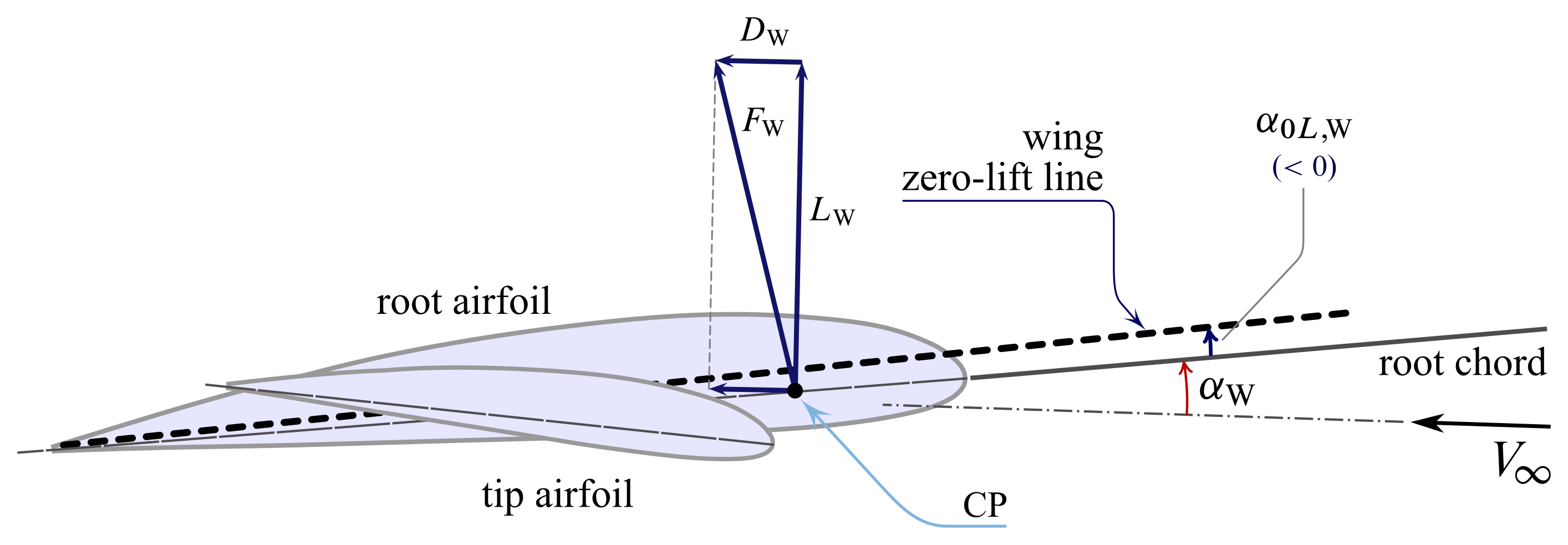
Due to the high values of aerodinamic efficiencies of airfoils and wings, often one can neglect the drag component in the above constructions, i.e. $d\approx 0$ and $D_\mathrm{W}\approx 0$.
Aerodynamic Center
The figure below represents an airfoil at a given angle of attack $\alpha$. The pressure and tangential stress distributions on the airfoils are reduced, if one neglects the drag, to the sole lift $\ell$ applied to the center of pressure. It is known from aerodynamics that, for a fixed airspeed $V_\infty$, an increasing angle of attack determines an increase of $\ell$ and a movement of the point $\mathrm{CP}$ along the chord towards the leading edge. This forward shift takes place until $\alpha$ reaches the stall angle of attack $\alpha_\mathrm{stall}$ of the airfoil then, for a further increase of $\alpha$, the center of pressure starts moving backwards.

On the other end, for decreasing $\alpha$’s the center of pressure shifts backwards while $\ell$ decreases. The point $\mathrm{CP}$ tends to move infinitely downstream as $\alpha$ approaches the angle $\alpha_{0\ell}$ and $\ell$ tends to zero.
It should be noted that, being the system of external aerodynamic forces equivalent to the force $\ell$ applied in $\mathrm{CP}$, the moment $m_P$ per unit span of aerodynamic forces with respect to a given pole $P$ is equal to the moment of the reduced system with respect to $P$. The figure below explains this concept.
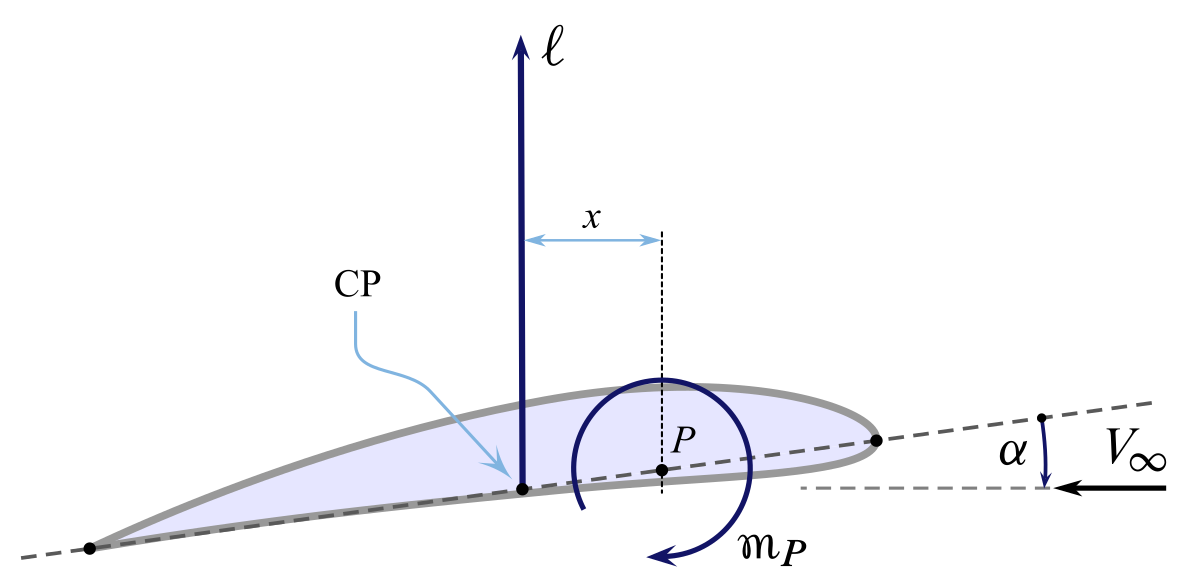
If $x$ is the arm of $\mathrm{CP}$ to $P$ the aerodynamic moment is
\begin{equation} m_P = - \ell \, x \label{eq:Airfoil:Moment:P} \end{equation}
For $\ell$ and $x$ positive as shown, the resulting pitch-down couple is negative by definition. If the angle of attack changes, both $\ell$ and $x$ will change and so will do $m_P$.
The variability of the aerodynamic reduction point $\mathrm{CP}$ is an unfavourable circumstance when the aerodynamic behaviour of wings and tailplanes have to be evaluated to assess the pitching equilibrium or pitching dynamics of a complete aircraft. Fortunately, the experimental evidence confirms the existence of a particular focal point along the chord of airfoils that exhibits a unique property: the pitching moment of the lift with respect to this point is invariant with the angle of attack. This particular pole is called aerodynamic center (ac) and for slender airfoils it is located approximately at a distance of $c/4$ from the leading edge.
A qualitative plot of the airfoil moment coefficient with respect to the quarter chord point \begin{equation} C_{m_{c/4}} = \frac{m_{c/4}}{\frac{1}{2}\rho V^2 c^2} \label{eq:Airfoil:Moment:c4} \end{equation}
is reported in the next figure.
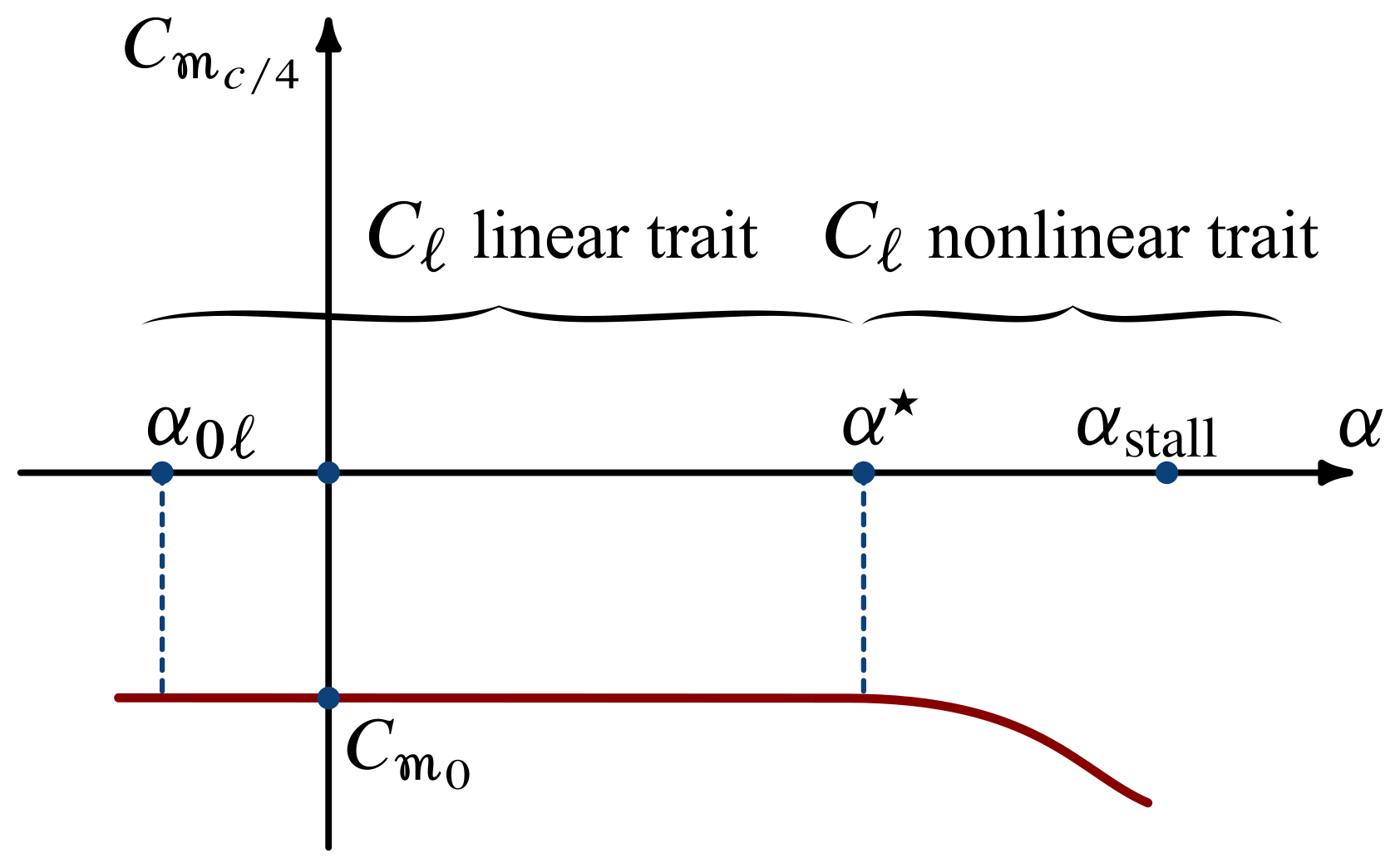
The non-variability of $C_{m_{c/4}}$ of airfoils with the angle of attack is well explained by the following figure, where four conditions of increasing $\alpha$ are considered.
- In the first condition, at an angle $\alpha = \alpha_{0\ell}$, the $\mathrm{CP}$ is located ideally at a distance $x\rightarrow\infty$ from the pole, yet the lift $\ell = 0$. The aerodinamic pressures and tangential stresses at the profile surface have a zero resultant but are not null, and their resultant pitching moment with respect to the pole is non-null either being equal to $C_{m_0}$. In such a case, when the resultant is zero, the aerodynamics of the airfoil is reduced to a sole free couple.
- In the subsequent conditions, from 3 to 4, the resultant $\ell$ is not null but the advancing $\mathrm{CP}$ and the increasing lift are such that the product $-\ell\,x$ remains equal to $C_{m_0}$.
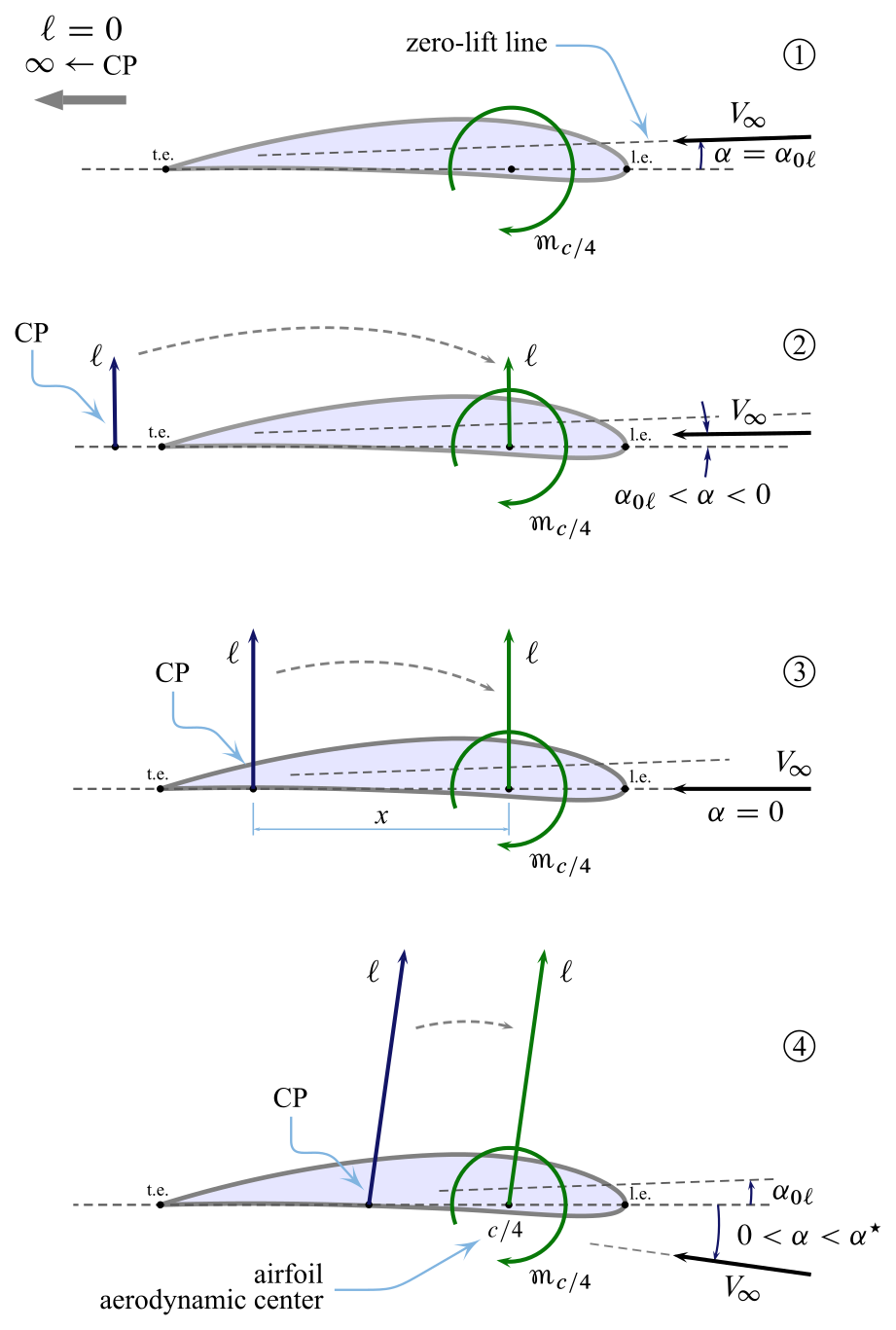
The four conditions considered in the previous figure are reported below on the curves of $C_\ell$ and $C_{m_{c/4}}$ as functions of $\alpha$. It must be noted that the existence of a focal point is justifiable strictly for those angles of attack within the $C_\ell$ linearity range.
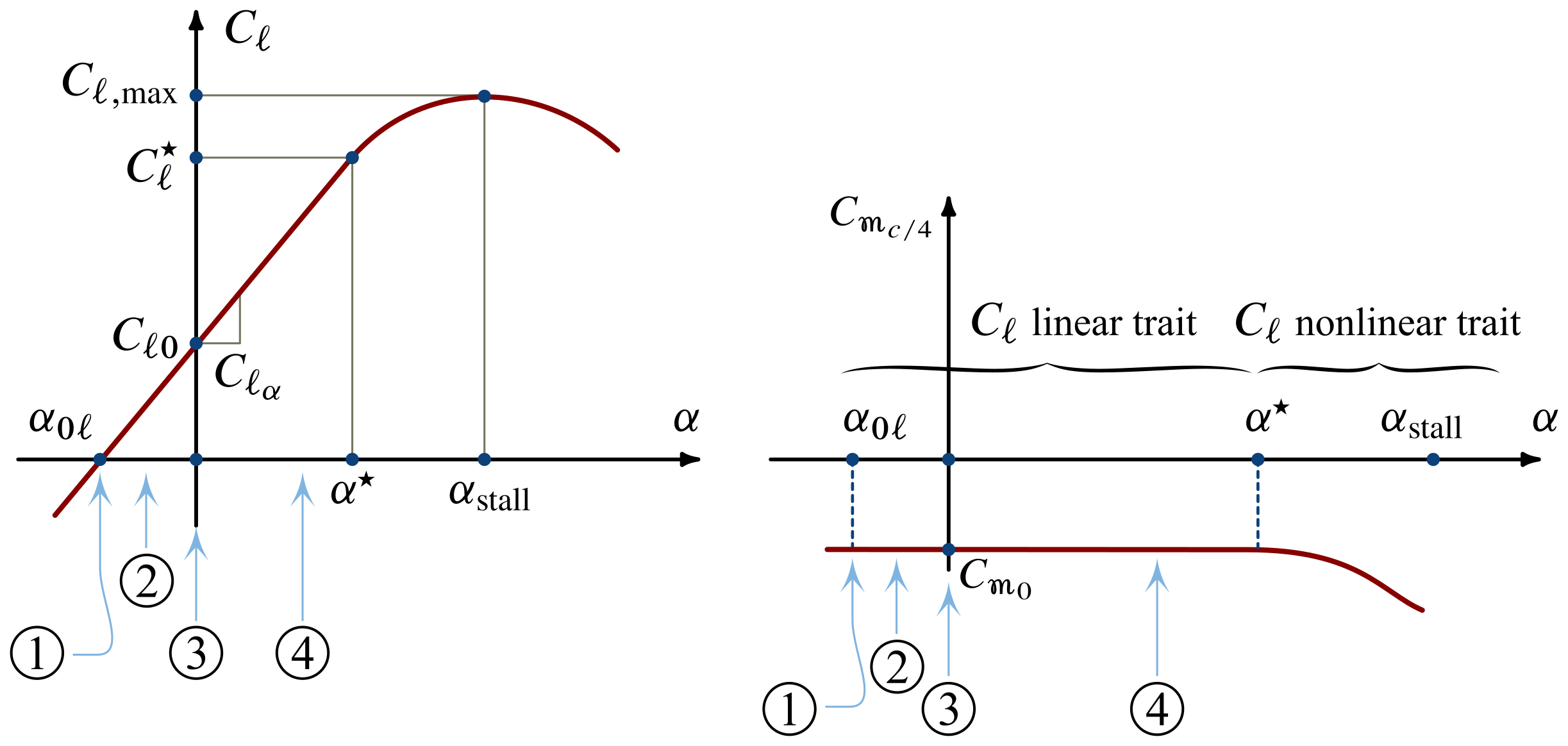
Finite wings are three-dimensional lifting surfaces that have the same characterisics of airfoils. Therefore, an aerodynamic center also exists for wings. As shown in the next top view of a wing, in the three-dimensional case the focal point ‘ac’ is in the symmetry plane, somewhere on the root chord or, according to the situation, on the projection of the mean aerodynamic chord.

For wings one can speak of focal axis, i.e. a pitch axis passing through the aerodynamic center and such that the pitching coefficient
This is confirmed by the next plot for all angles of attack $\alpha_{0L,\mathrm{W}} \le \alpha_\mathrm{W} \le \alpha_\mathrm{W}^\star$.
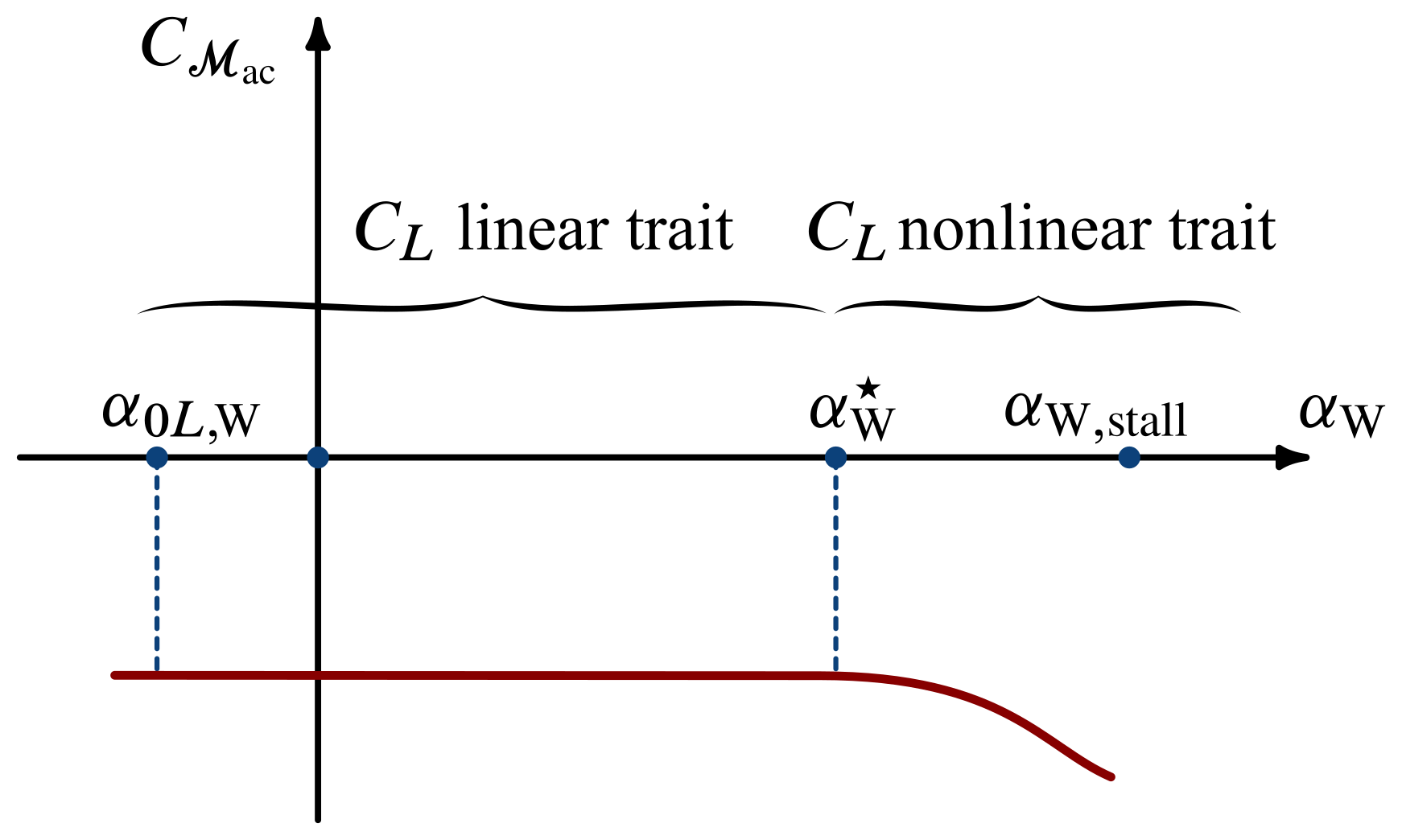
The existence of the aerodynamic center of wings, i.e. a pitch focal axis, is such a favourable circumstance: as the angle of attack changes, the aerodynamic effect of the airflow over the lifting surface can be reduced to the lift $L_\mathrm{W}$ applied to the fixed point ‘ac’ and to a constant moment $\mathcal{M}_\mathrm{ac}$ about the same pole.
A very important practical outcome of this circumstance is illustrated by the next figure. When one needs to evaluate the aircraft baricentric pitching moment due to the aerodynamics of the wing, it can be simply calculated by multiplying $L_\mathrm{W}$ times the arm $a$ and then adding the couple $\mathcal{M}_\mathrm{ac,W}$.

Therefore, the pitching moment of the wing about the aircraft center of gravity $G$ is:
The corresponding pitching moment coefficient
can be calculated considering that
and substituting into the expression (\ref{eq:Wing:Moment:G}), to obtain the equation:
The above expression can be rearranged as the following linear formula in $\alpha_\mathrm{B}$:
where the two constants are defined as:
The above two constants are known by the designers, for a given flight condition, once the geometry of the wing and the center of gravity position are known.
Effect of the fuselage
When a wing-fuselage configuration is considered, also called wing-body by engineers, the concept of aerodynamic center (or focal pitch axis) remains. Fuselages of conventional airplanes develop almost no lift but are subject to a pitching moment due to airflow. By adding the fuselage to the wing it can be shown that their combination still exhibits an aerodynamic center.
The figure below shows a side view of an airliner.
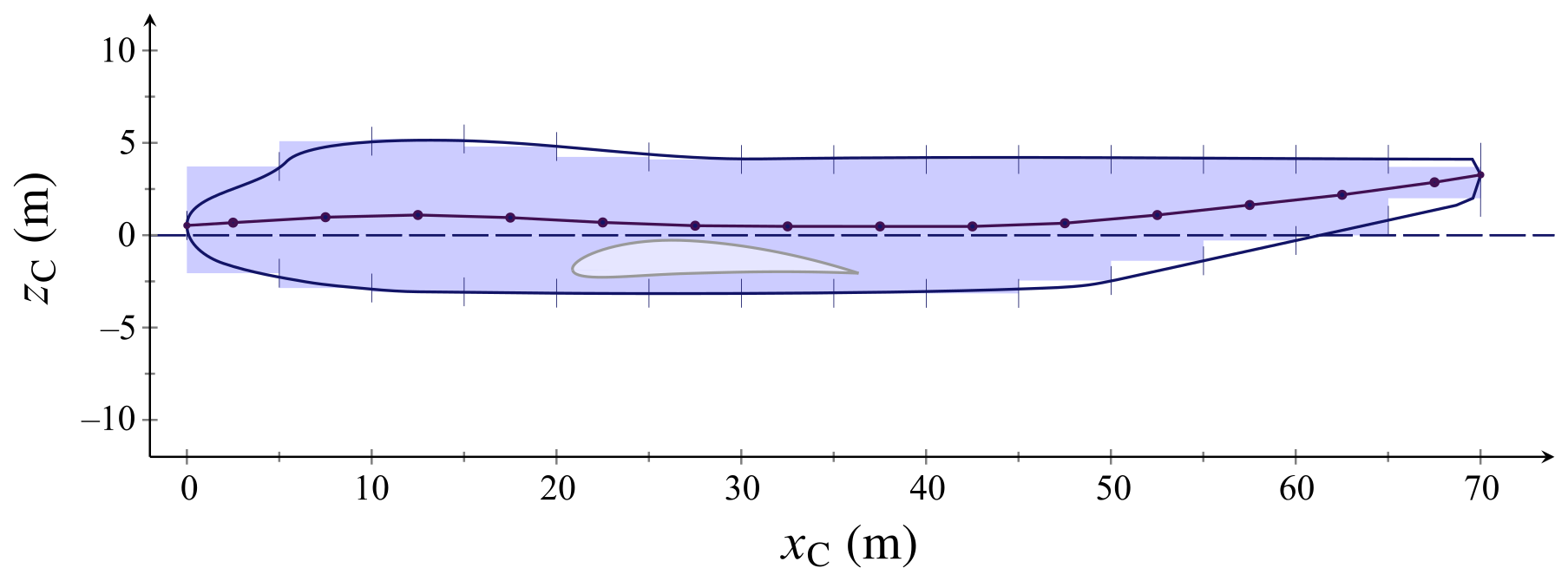
This particular shape, when immersed in an air stream at an angle of attack $\alpha_\mathrm{B}$, generates a pitching moment $\mathcal{M}_{\mathrm{B}}$. A typical behaviour of this kind of stretched, cylinder-like shapes is shown in the next plot representing the pitching moment coefficient of the fuselage
as a function of the angle of attack.

The positive slope of the above linear dependency from $\alpha_\mathrm{B}$ is un unfavourable circumstance for the longitudinal stability of airplanes.
The aircraft longitudinal stability is discussed in more detail in the section on pitch stability and control .
The important practical outcome of the above discussion is illustrated by the next figure. When one considers the wing-fuselage (WB) combination, typically the aerodynamic center shifts forwards with respect to the original position determined for the isolated wing (W). Therefore, in the top view reported below the wing-body aerodynamic center is located at the distance $x_{\mathrm{ac,WB}}$ from the leading edge of the wing aerodynamic chord $\bar{c}$, which is less than the distance $x_{\mathrm{ac,W}}$ of the focal axis of the isolated wing.
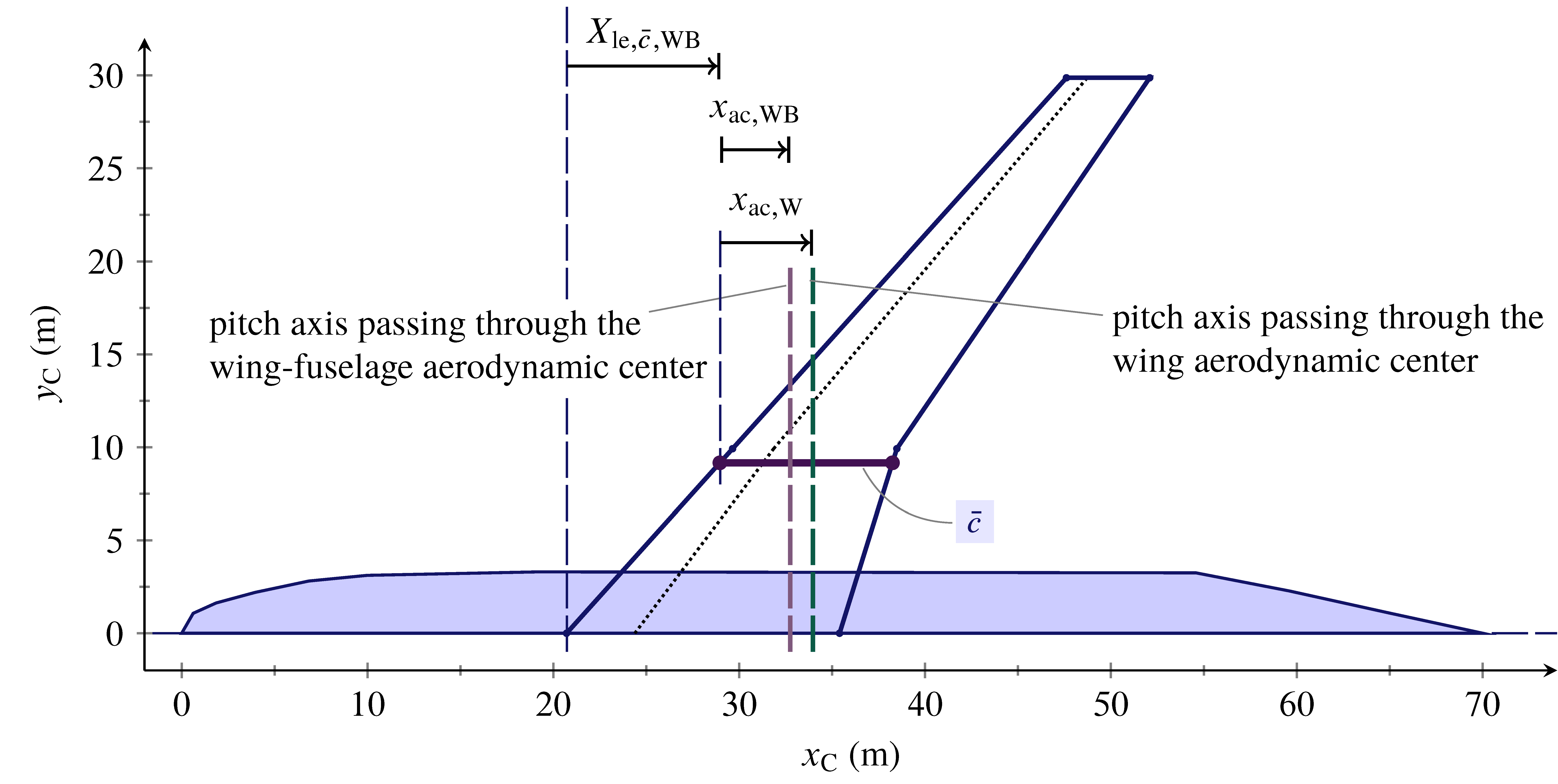
In other terms, the presence of the fuselage does not add a significant lifting capacity to the wing but moves the aerodynamic center towards the nose.